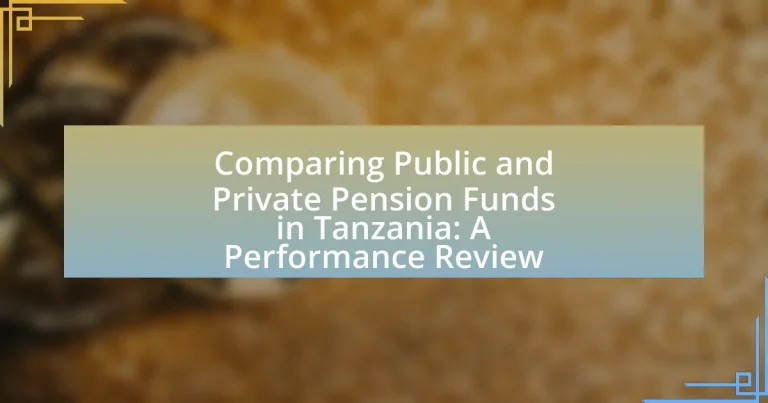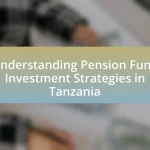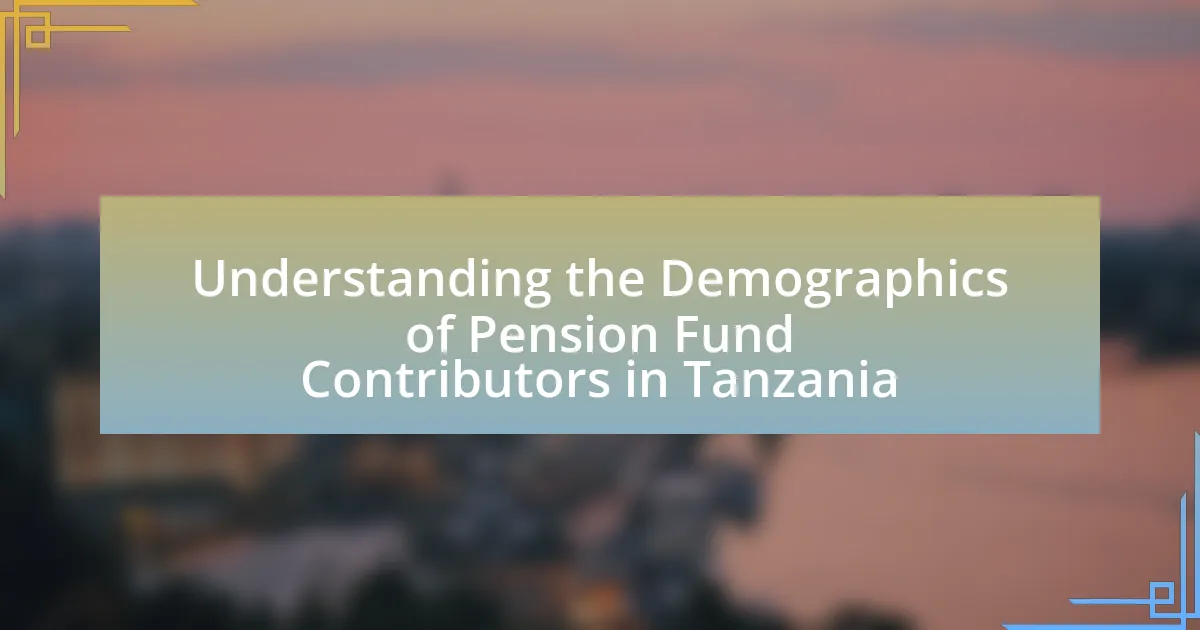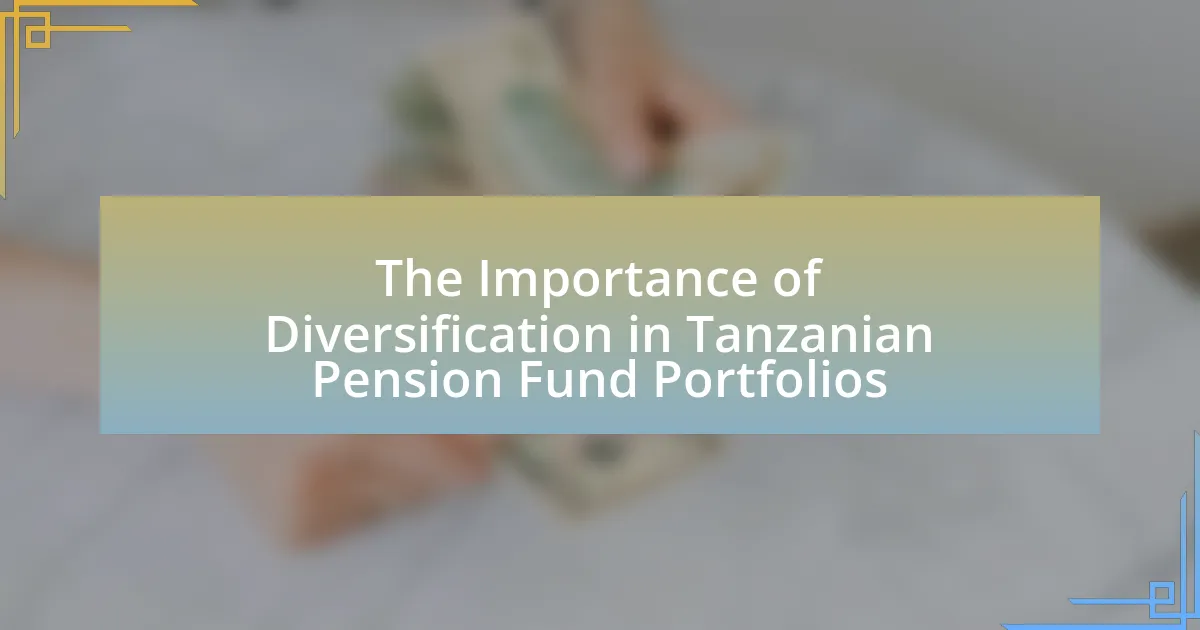The article focuses on the comparison of public and private pension funds in Tanzania, examining their structures, operations, and performance metrics. Public pension funds, managed by the government, provide retirement benefits primarily to public sector employees and are regulated by the National Social Security Fund (NSSF) and the Public Service Pensions Fund (PSPF). In contrast, private pension funds, established by private entities, offer more flexible investment options and are regulated by the Retirement Benefits Authority (RBA). The article analyzes the historical performance trends, risk profiles, and implications for retirees, highlighting the differences in returns and financial security provided by each type of fund. Additionally, it discusses best practices for improving pension fund performance through diversification, transparency, and governance.

What are Public and Private Pension Funds in Tanzania?
Public pension funds in Tanzania are government-managed retirement savings schemes designed to provide financial security to public sector employees upon retirement. These funds are typically financed through mandatory contributions from employees and employers, and they are regulated by the National Social Security Fund (NSSF) and the Public Service Pensions Fund (PSPF).
Private pension funds, on the other hand, are established by private sector employers or financial institutions to offer retirement benefits to their employees. These funds operate independently of government oversight and are subject to different regulatory frameworks, primarily governed by the Insurance Regulatory Authority (IRA) in Tanzania.
Both types of pension funds aim to ensure that individuals have adequate income during retirement, but they differ in their management, funding sources, and regulatory environments. Public pension funds are often larger and more stable due to government backing, while private pension funds may offer more flexibility and investment options.
How do Public Pension Funds operate in Tanzania?
Public pension funds in Tanzania operate under the regulatory framework established by the National Social Security Fund (NSSF) and other statutory bodies, which manage contributions from employees and employers. These funds are designed to provide retirement benefits, disability allowances, and survivor benefits to members, primarily funded through mandatory contributions from formal sector workers, which are typically set at 10% of the employee’s salary, matched by the employer.
The NSSF, established in 1997, is the largest public pension fund in Tanzania, and it invests contributions in various sectors, including real estate, infrastructure, and financial markets, to ensure sustainable growth and returns for its members. As of 2021, the NSSF reported assets exceeding 5 trillion Tanzanian Shillings, reflecting its significant role in the national economy and its capacity to provide financial security to retirees.
What are the key characteristics of Public Pension Funds?
Public pension funds are characterized by their government sponsorship, defined benefit structures, and long-term investment horizons. These funds are primarily established to provide retirement income to public sector employees, ensuring financial security in retirement. They typically operate under regulatory frameworks that mandate funding levels and investment strategies, which can include a mix of equities, bonds, and alternative investments. Public pension funds often benefit from economies of scale, allowing for lower administrative costs and greater bargaining power in investment negotiations. Additionally, they are subject to public accountability and transparency requirements, which can enhance trust among beneficiaries and stakeholders.
How are Public Pension Funds regulated in Tanzania?
Public Pension Funds in Tanzania are regulated primarily by the National Social Security Fund (NSSF) and the Public Service Pensions Fund (PSPF), which operate under the Ministry of Finance and Planning. These funds are governed by the Social Security Regulatory Authority (SSRA), established to oversee compliance with the Social Security Laws of 2008. The SSRA ensures that pension funds adhere to investment guidelines, financial reporting standards, and member benefits, thereby safeguarding the interests of contributors. Additionally, the regulatory framework mandates regular audits and performance assessments to maintain transparency and accountability within the pension system.
What are Private Pension Funds in Tanzania?
Private pension funds in Tanzania are financial institutions that manage retirement savings for individuals, providing them with investment options to grow their funds over time. These funds operate independently from the government-managed public pension schemes and are designed to supplement retirement income. According to the National Social Security Fund (NSSF) of Tanzania, private pension funds have been established to enhance the retirement savings landscape, offering various investment strategies and benefits tailored to individual needs. The regulatory framework governing these funds is outlined in the Pension Act of 2008, which ensures their operation under specific guidelines to protect members’ interests.
What distinguishes Private Pension Funds from Public ones?
Private Pension Funds are distinguished from Public Pension Funds primarily by their ownership structure and funding sources. Private Pension Funds are typically established by private entities or corporations and are funded through contributions from employees and employers, whereas Public Pension Funds are government-managed and funded through taxpayer contributions and government allocations. This difference in funding sources leads to variations in investment strategies, regulatory oversight, and benefit structures, with Private Pension Funds often having more flexibility in investment choices compared to the more conservative approach of Public Pension Funds, which are subject to stricter regulations to ensure the security of public funds.
How are Private Pension Funds managed and regulated?
Private pension funds are managed by professional fund managers who make investment decisions based on the fund’s objectives and regulatory guidelines. In Tanzania, these funds are regulated by the Retirement Benefits Authority (RBA), which ensures compliance with the Retirement Benefits Act of 2008. The RBA sets standards for fund management, investment strategies, and reporting requirements to protect the interests of members and ensure the sustainability of the funds. Additionally, regular audits and performance assessments are mandated to maintain transparency and accountability in fund operations.

What are the performance metrics for comparing Pension Funds?
The performance metrics for comparing pension funds include return on investment (ROI), risk-adjusted return, expense ratios, funding ratios, and participant satisfaction. ROI measures the profitability of the fund, while risk-adjusted return evaluates performance relative to the risk taken, often using metrics like Sharpe ratio. Expense ratios indicate the cost of managing the fund, affecting net returns. Funding ratios assess the financial health of the fund by comparing assets to liabilities. Participant satisfaction reflects the perceived value and service quality provided by the fund. These metrics provide a comprehensive view of pension fund performance, enabling effective comparisons.
How is the performance of Pension Funds measured?
The performance of pension funds is measured primarily through their investment returns, which are assessed against benchmarks such as market indices or peer group averages. This evaluation includes metrics like the rate of return, risk-adjusted return, and the fund’s ability to meet its long-term liabilities. For instance, a pension fund’s performance can be compared to the average return of similar funds or to a relevant index, providing a clear context for its effectiveness. Additionally, factors such as expense ratios and funding ratios are analyzed to gauge operational efficiency and financial health, respectively. These metrics collectively offer a comprehensive view of how well a pension fund is performing in fulfilling its obligations to beneficiaries.
What financial indicators are used to assess Pension Fund performance?
Financial indicators used to assess Pension Fund performance include the rate of return on investments, funding ratio, expense ratio, and asset allocation. The rate of return measures the profitability of the fund’s investments over a specific period, indicating how well the fund is growing its assets. The funding ratio compares the fund’s assets to its liabilities, providing insight into its financial health and ability to meet future obligations. The expense ratio reflects the costs associated with managing the fund, which can impact overall returns. Lastly, asset allocation assesses the distribution of investments across various asset classes, influencing risk and return profiles. These indicators collectively provide a comprehensive view of a pension fund’s performance and sustainability.
How do risk and return profiles differ between Public and Private Pension Funds?
Public pension funds typically exhibit lower risk and more stable returns compared to private pension funds, which tend to have higher risk and potentially higher returns. Public pension funds are often backed by government guarantees and invest in a diversified portfolio of low-risk assets, resulting in more predictable performance. In contrast, private pension funds may pursue aggressive investment strategies, including equities and alternative investments, leading to greater volatility and the possibility of higher returns. This difference is evidenced by historical data showing that public pension funds have lower standard deviations in returns, indicating less risk, while private funds often achieve higher average returns over the long term, reflecting their willingness to accept greater risk for potential rewards.
What are the historical performance trends of Pension Funds in Tanzania?
The historical performance trends of pension funds in Tanzania indicate a gradual increase in asset growth and investment returns over the past two decades. According to the National Social Security Fund (NSSF) reports, pension fund assets grew from approximately 1.5 trillion Tanzanian Shillings in 2000 to over 10 trillion Tanzanian Shillings by 2020, reflecting a compound annual growth rate of around 15%. Additionally, the average return on investments for pension funds has ranged between 8% to 12% annually, influenced by factors such as economic growth, regulatory changes, and market conditions. The performance of private pension funds has generally outpaced public funds, with private entities achieving higher returns due to more aggressive investment strategies and diversified portfolios.
How have Public Pension Funds performed over the last decade?
Public pension funds have generally experienced moderate growth over the last decade, with average annual returns ranging from 6% to 8%. This performance is attributed to a combination of factors, including diversified investment strategies and recovery from the financial crisis. For instance, according to the National Association of State Retirement Administrators, public pension funds in the United States reported a median return of 7.2% for the fiscal year 2021, reflecting a rebound from previous years impacted by market volatility. Additionally, the Pew Charitable Trusts noted that many public pension funds have improved their funding ratios, with some reaching over 80% funded status, indicating enhanced financial stability.
What trends have been observed in the performance of Private Pension Funds?
Private Pension Funds in Tanzania have shown a trend of increasing returns over the past decade, outperforming public pension funds in several key metrics. For instance, data from the National Social Security Fund indicates that private pension funds achieved an average annual return of 8.5% compared to the 6.2% return of public funds from 2010 to 2020. Additionally, private pension funds have demonstrated greater asset diversification, which has contributed to their resilience during economic downturns. This trend is supported by the growing number of participants in private pension schemes, reflecting a shift in public confidence towards private management of retirement savings.

What are the implications of the performance comparison?
The implications of the performance comparison between public and private pension funds in Tanzania indicate significant differences in investment returns and risk management strategies. Public pension funds often exhibit lower returns due to conservative investment approaches, while private pension funds tend to achieve higher returns through diversified portfolios and aggressive investment strategies. This performance disparity suggests that stakeholders, including policymakers and investors, may need to reconsider the regulatory frameworks governing public pension funds to enhance their competitiveness. Additionally, the findings highlight the importance of adopting best practices from private funds to improve the overall efficiency and sustainability of pension systems in Tanzania.
How do the performance differences affect retirees in Tanzania?
Performance differences between public and private pension funds significantly impact retirees in Tanzania by influencing their financial security and quality of life. Retirees relying on public pension funds often receive lower benefits due to underfunding and inefficiencies, which can lead to poverty and inadequate living standards. In contrast, private pension funds typically offer higher returns and better management, resulting in more substantial payouts for retirees. For instance, a study by the Bank of Tanzania in 2021 indicated that private pension funds had an average annual return of 10%, compared to only 5% for public funds. This disparity means that retirees with private pensions are more likely to maintain a comfortable lifestyle, while those dependent on public pensions face greater economic challenges.
What are the potential risks for retirees relying on Public Pension Funds?
Retirees relying on Public Pension Funds face several potential risks, including funding shortfalls, political interference, and inflation. Funding shortfalls occur when the pension fund’s liabilities exceed its assets, which can lead to reduced benefits; for instance, many public pension systems in various countries have reported significant unfunded liabilities, raising concerns about their long-term viability. Political interference can result in changes to pension policies or benefit structures, often influenced by budgetary constraints or shifting political priorities, which can jeopardize the stability of retirees’ income. Additionally, inflation poses a risk as fixed pension benefits may not keep pace with rising living costs, diminishing retirees’ purchasing power over time. These factors collectively highlight the vulnerabilities associated with relying solely on Public Pension Funds for retirement income.
How can Private Pension Funds provide better security for retirees?
Private Pension Funds can provide better security for retirees by offering higher returns on investments compared to public pension funds. Research indicates that private pension funds often have more flexibility in investment strategies, allowing them to allocate assets in a way that can yield greater growth. For instance, a study by the World Bank in 2021 found that private pension funds in various countries achieved average annual returns of 6-8%, while public pension funds typically averaged around 4-5%. This difference in returns can significantly enhance the retirement savings of individuals, leading to improved financial security in retirement. Additionally, private pension funds may offer personalized investment options, allowing retirees to tailor their portfolios according to their risk tolerance and retirement goals, further contributing to their financial stability.
What best practices can be adopted for improving Pension Fund performance?
To improve Pension Fund performance, adopting a diversified investment strategy is essential. Diversification reduces risk and enhances returns by spreading investments across various asset classes, such as equities, bonds, and real estate. Research indicates that pension funds with a diversified portfolio can achieve higher risk-adjusted returns, as evidenced by a study from the CFA Institute, which found that diversified funds outperformed concentrated funds by an average of 2% annually over a decade. Additionally, implementing robust governance structures, including regular performance reviews and transparent reporting, can further enhance accountability and decision-making, leading to improved fund performance.
How can transparency and governance enhance Pension Fund outcomes?
Transparency and governance can enhance Pension Fund outcomes by fostering accountability and trust among stakeholders, which leads to better investment decisions and improved financial performance. When pension funds operate transparently, they provide clear information about their investment strategies, fees, and performance metrics, allowing stakeholders to make informed decisions. Research indicates that funds with strong governance structures tend to achieve higher returns; for instance, a study by the Organisation for Economic Co-operation and Development (OECD) found that well-governed pension funds can outperform their peers by as much as 1-2% annually. This is attributed to effective risk management and strategic asset allocation driven by informed oversight. Therefore, enhanced transparency and governance directly correlate with improved outcomes for pension funds.
What strategies can Pension Funds implement to optimize returns?
Pension funds can optimize returns by diversifying their investment portfolios across various asset classes, including equities, fixed income, real estate, and alternative investments. Diversification reduces risk and enhances potential returns by spreading investments across different sectors and geographies. For instance, a study by the World Bank indicates that pension funds with diversified portfolios have historically achieved higher returns compared to those concentrated in a single asset class. Additionally, implementing active management strategies, such as tactical asset allocation and dynamic rebalancing, allows pension funds to respond to market changes and capitalize on emerging opportunities, further enhancing return potential.





